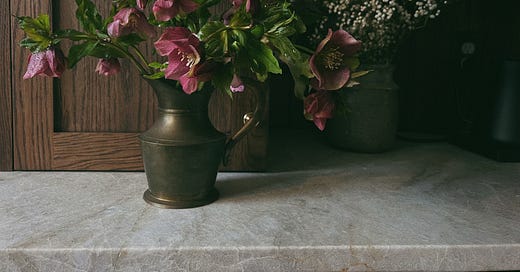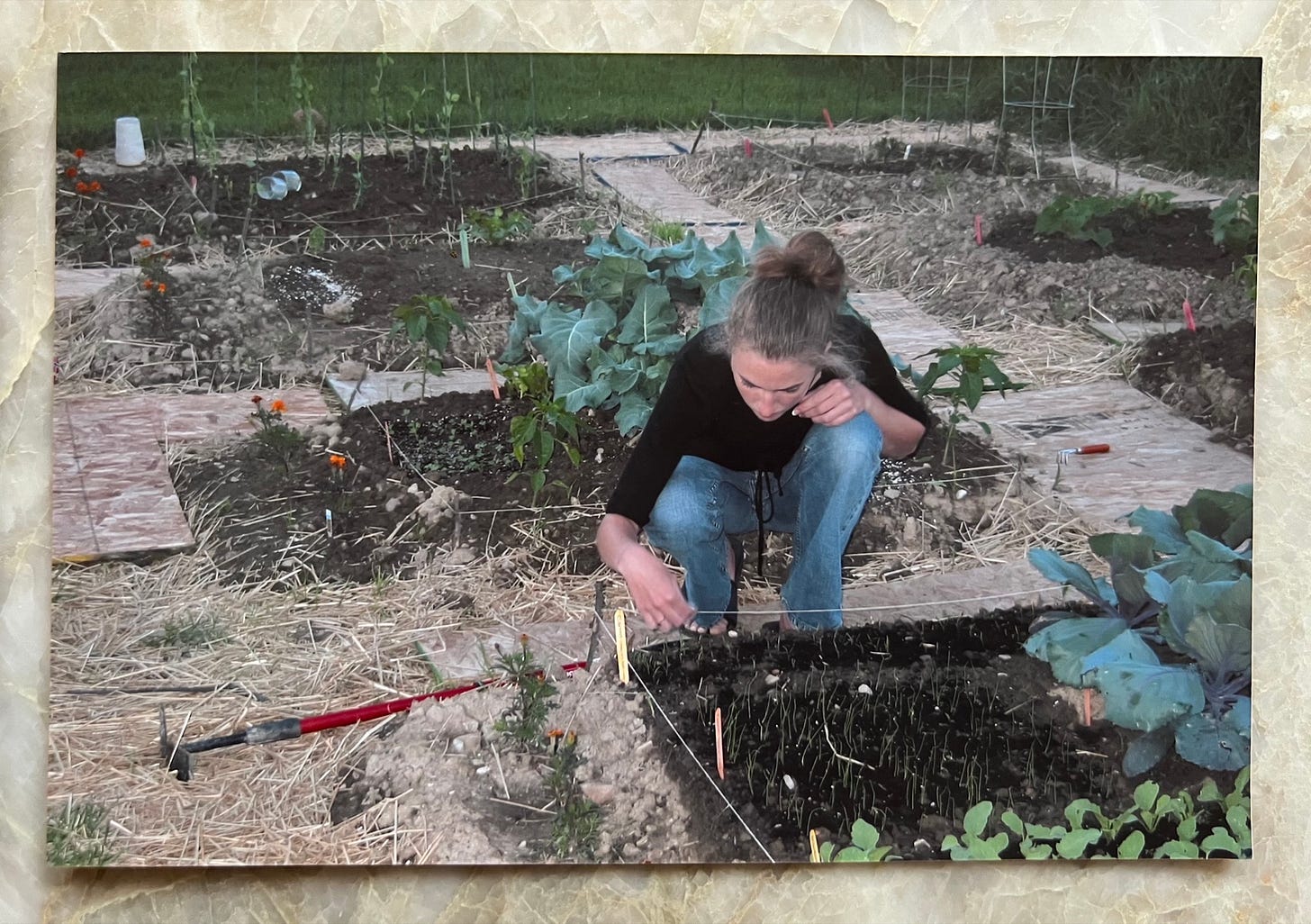✍🏻 a critique of my personal garden
with 2024's garden plans & heat tolerant recommendations ☀️
🧹 Housekeeping! 🧹
Virtual Garden Club is tomorrow, February 1st at 7pm.
I have online classes for starting seeds indoors and improving your soil here.
Forsyth Co. Extension’s February events are here.

My Personal Garden
When we bought our first home in 2018, my only in-ground garden planning experience was with square foot gardening as a child. (I had done lots of container and patio gardening in apartments as an adult.)
I personally measured, designed, and plotted out a 20x56’ rectangle in our family backyard. No one asked me to create and maintain the family garden, but I found Mel Gibson’s book in the library. I was the kid who rented 30 books at a time — and this one scratched my brain’s itch for drawing squares and other repetitive things.
I knew when we bought our home that I wanted to garden, but we were desperate and the market was rough.
Things like “what direction is the home oriented” and “how many hours of sunlight does it get in front and back” were not questions we were asking in the 2 hours we had to decide to make an offer. Plus, as a non-gardener at that time, it just seemed “sunny” because “the sun was out.” And surprisingly, I fell in love with this home because something about the shady overgrown jungle reminded me of a version of home I felt very very early in my life.
A week after we closed on our home, a storm rolled through, felling a giant pine at the back of our property line that crashed through the side of our detached garage, took out the one crepe myrtle in the backyard, and clipped the roof of the home.
I was devastated. Our beautiful yard felt destroyed instantaneously.
Sometimes I think about how much trees know — standing for decades and centuries at a time, watching humans beneath them scramble about.
Maybe that great pine tree knew that only a couple years later my life would be oriented around gardening, gardening, gardening. That I would be searching for every minute of direct sun I could find in our little 1/4 acre. And it gave me just enough to grow in.
A Critique
Skipping ahead through five years of removing our driveway, building beds, planting perennials in a chaotic manner, adding chickens, compost bins, pathways, and rain barrels — my backyard is lovely but often very problematic.
This year I am shifting to focus on adding as many flowers for cutting as I can squeeze in — while still growing our veg & herb staples.
Challenge 1: Sunshine
Sun remains one of the primary issues as neighbors on both East and West sides have rapidly growing trees that cast more shade each year. This means I have a mid-strip through the backyard that gets just barely full sun (about 8 hours a day) in summer — highlighted in yellow. The rest of the yard is partial shade.
House hunting tip: You want your backyard or growing site positioned OPPOSITE of mine. South-facing is best. Sometimes partial shade is nice for the deep south with our hot heat, but my yard is morning shade, afternoon sun when it’s brutal. The opposite would have allowed me better results.

The two lavender-colored beds need a new plan. The only edibles that can handle partial sun/partial shade are leafy greens — and unfortunately the longest bed has such a chipmunk and vole problem that only sturdy perennials can survive it. Anything that goes in as a seedling, flower or veg, gets eaten instantly.
My solution: For the long lavender bed down the side, I am going to relocate my bleeding hearts and add astilbe, a generous gardener rose, and 1-2 macrophylla hydrangeas. Generous Gardener has done well for me so far in partial sun, and macrophylla hydrangeas prefer it. (Remember to grow panicle varieties in full sun areas, and oakleafs in full shade.) This will function as a perennials-for-cut-flower area.
Challenge 2: Vertical trellising
Hands down the most irritating mistake I made when designing the flow of pathways and position of raised beds is not planning for a balanced way to add vertical trellising or arches.
Adding arches over the entrances to the two U shaped beds ruins the view of the pretty garage/garden shed and feels clunky in the center of the yard. I wish I had rotated the U beds so that the trellising would run down the center, rather than left/right side.
I love arches for signaling transitions to a new space, and hypothetically they should work here — but the beds should have been much deeper and been squared off to the edge, because it looks awkward having arches that jut off the sides of the garage. Plus they hit the gutters.
The other issue with vertical trellising is that they cast shade -- something I do not need more of. If you are limited on sun, you want any vertical height to be positioned on the West side of the garden.
My solution: I think I must give up on my beloved arches, and use flat vertical trellising on the backsides of the three western-most raised beds. I used to have netting running along the garage which was very effective (but an eyesore). I will invest in more permanent solution — iron wall trellising on the side of the garage. I will also invest in 4 obelisks to add some symmetry and balance to the center. (Someone find me more affordable obelisks than these!)
Challenge 3: Dead Turf Zone
As the yard has been converted to productive spaces, this blue rectangle below has remained a sad mess of native weeds and clover. It has been useful to leave open as a work space, so I am hesitant to add in more beds or structures — but I do not love how weedy it is, and Max is tired of mowing it.
My solution: This year I am going to try turning it into a giant sweet potato patch! I have seen several people using sweet potatoes as ground cover. NC is perfect for them — 40% of the national supply of sweet potatoes are grown here.
Sweet potatoes are not year round here in zone 7b/8a (I *think* they are in Florida), but they are planted in May and they do not need to be harvested all at once. You can dig up what you want beginning in August, and continue to go out and dig potatoes all the way until a few weeks after frost (usually in Nov).
My hope is that sweet potatoes (and then an early spring cover crop) will improve the soil dramatically over the next 2 years and by then I’ll want to do something else with the space.
Challenge 4: Limited Space for both Cut Flowers & Veggies
I know I have much more space than the casual garden, but I WANT TO GROW EVERYTHING. My strategies for growing in limited space are:
Plant annual flowers in vegetable beds with veggies rather than growing them separately
Plant densely with Square Foot Gardening method and harvest fast so beds do not become overgrown
Succession plan with cool-then-warm-season plants. For example, I can mark a 4x4’ spot for lettuce from Feb to May and then transition to zinnias and bush beans a few weeks after the last frost once the soil has warmed. Once the bush beans have been harvested 2-3 months later, I can plant a second round of bush beans or switch to a fast growing green like bok choi, arugula, or spinach that will enjoy the partial protection of zinnias. (This IS challenging for new gardeners; my calendar helps a lot)
Large containers/pots for the annoying veg that take a long time to grow and a lot of space per plant. Bell peppers, eggplant, and winter squashes can eat up your entire bed space. I started planting these in big containers and setting them around the property so that their overflow flows into pathways or unused spaces rather than where other vegetables are trying to grow. Just know you need a pot at least 18” wide and to put it on drip irrigation or water it faithfully. Anything planted above ground will dry out fast and the soil temp will stay warmer.
Saying no to long maturation plants with low production. Cabbage, broccoli, cauliflower, brussels, winter squash, watermelon, pumpkins, and shell beans can take up an enormous amount of space for 4+ months, and one plant does not provide you with much. (You can grow about 72 carrots in the same time and space as a cabbage. When mapping your garden consider how many plants per square foot x how many months) All of these are being cut from my garden this year so that I can add cut flowers and focus on fast growing veg/herbs that I can succession plant.
Challenge 5: Heat!
The majority of warm season vegetables handle high heat and even drought fairly well. I have not had issues with any tomatoes, squash, eggplant, bell peppers, okra, beans, etc that I have grown.
The biggest issue we have in the southeast is with cool season vegetables. They are planted in early spring and often bolt early or are killed off / run bitter because we get heat waves earlyyyyy.
Here are some varieties of cool season plants that tolerate heat unusually well:
Batavian Lettuce - can germinate in soil temps above 80°
Crawford Bibb - a reliable favorite, can even handle TX heat
Wando Dwarf Pea - heat resistant for areas that warm up fast in the spring!
Ashley Cucumber - for hot humid locations and mildew resistant
Danvers 126 Carrot - the last interesting carrot but most successful in my garden
Golden Acre Cabbage - most cabbages take 3 months but this one only 2!
Waltham 29 Broccoli - rapid growing. for spring need to be transplanted out by early april (so seed indoor by late feb). trickiest SE crop; more info here.
My Full Calendar for 2024
If you want to see my personal year-round veggie calendar, you can view it here! It’s about 90% complete and I will be adding cut flowers into it shortly.
Until next time,
Lauren xo
“Never trust a thought that occurs to you indoors.” Friedrich Nietzsche






















